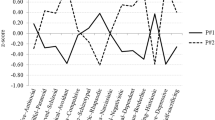Abstract
Low correlations among personal space measures have been used as evidence against their convergent validity. This argument is analyzed and found limited to personality trait assumptions. Convergent validity more generally concerns whether findings from one measure generalize to other measures. In the present study 91 subjects completed three measures (a disguised interaction distance, figure placement distances, and the Comfortable Interpersonal Distance Scale) under different conditions of subject sex, sex of the other person, and acquaintance with the other person. The three measures showed an average intercorrelation ofr = .034, but consistent significant effects of acquaintance. These findings demonstrate that convergence of findings may be obtained even when measures are not highly correlated. The search for convergent validity should concentrate on the generalizability of findings rather than correlations among measures.
Similar content being viewed by others
References
Becker, F. D., & Mayo, C. Delineating personal distance and territoriality.Environment and Behavior, 1971,3, 375–381.
Dosey, M., & Meisels, M. Personal space and self-protection.Journal of Personality and Social Psychology, 1969,11, 93–97.
Duke, M. P., & Nowicki, S., Jr. A new measure and social learning model for interpersonal distance.Journal of Experimental Research in Personality, 1972,6, 1–16.
Evans, G. W., & Howard, R. B. Personal space.Psychological Bulletin, 1973,80, 334–344.
Hayduk, L. A. Personal space: An evaluative and orienting overview.Psychological Bulletin, 1978,85, 117–134.
Horowitz, M. J., Duff, D. F., & Stratton, L. O. Body-buffer zone.Archives of General Psychiatry, 1964,11, 651–656.
Jones, S. E. A comparative proxemics analysis of dyadic interaction in selected subcultures of New York City.Journal of Social Psychology, 1971,84, 35–41.
Jones, S. E., & Aiello, J. R. Proxemic behavior of black and white first-, third-, and fifth-grade children.Journal of Personality and Social Psychology, 1973,25, 21–27.
Keuthe, J. Social schemas.Journal of Abnormal and Social Psychology, 1962,64, 31–36.
Knowles, E. S., & Johnson, P. K. Intrapersonal consistency in interpersonal distance.JSAS Catalog of Selected Documents in Psychology, 1974, Fall, No. 768, 1–27.
Little, K. B. Personal space.Journal of Experimental Social Psychology, 1965,1, 237–247.
Little, K. B., Ulehla, A., & Henderson, C. Value congruence and interaction distances.Journal of Social Psychology, 1968,75, 249–253.
Rosenthal, R. Combining results of independent studies.Psychological Bulletin, 1978,85, 185–193.
Rosenthal, R., & Rubin, D. B. Comparing significance levels of independent studies.Psychological Bulletin, 1979,86, 1165–1168.
Sundstrom, E., & Altman, I. Interpersonal relationships and personal space: Research review and theoretical model.Human Ecology, 1976,4, 47–67.
Reference Notes
Rawls, J., Trego, R., & McGaffey, C.A comparison of personal space measures and correlates of personal space. NASA Grant Report, Institute of Behavioral Research, Texas Christian University, 1968.
Alovisetti, M. C.Relationship between a projective and behavioral measure of personal space. Paper prepared at the University of Rhode Island and presented at the Eastern Psychological Association Convention, April 1977.
Zanni, G. R.An investigation of five personal space measures. Paper prepared at Elizabethtown College and presented at the Eastern Psychological Association Convention, April 1976.
Author information
Authors and Affiliations
Additional information
The author thanks Jan Beyer, Terri Bouressa, Lynn Brud, Pui Bunnag, Julia Coppedge, Randy Fleming, Barb Gallagher, Steve Hansen, Joe Hilke, Marcia Hostetter, Beth Lemke, Bridget Mader, Brian Maloney, Mary Martin, David Mueller, Michael Paprocki, Debra Rindt, Jan Salzmann, Caryn Schneider, Sonja Stefaniw, Cheryl Strong, and Kathy Wolf for conducting the study and assistance in writing the manuscript.
Rights and permissions
About this article
Cite this article
Knowles, E.S. Convergent validity of personal space measures: Consistent results with low intercorrelations. J Nonverbal Behav 4, 240–248 (1980). https://doi.org/10.1007/BF00986200
Issue Date:
DOI: https://doi.org/10.1007/BF00986200




